by Baxter
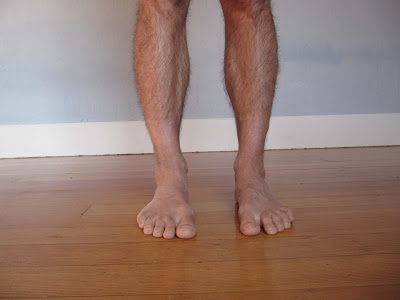
It was my first class with Donald Moyer in the new year. I checked in with him before class began and mentioned an unusual aching in the lateral aspect of my left foot that I had been experiencing for about two months. It was not bad enough from preventing me from my normal activities, but I noticed it when turning my left foot out to 90 degrees for many of my standing poses. He gave me some pointers for the day’s practice, and then class began.
About half way through the class, while we were in Standing Forward Bend (Uttanasana), Donald had us slip a strap between our big and second toes, and bring the loose end over the top of the big toe and down to the floor to the inside edge of the toe. He asked us to gently pull the strap to move the big toe medially, so that it lined up more evenly with the first metatarsal, the foot bone just before you get to the toe itself (the toe bones are called phalanges, and the big to has two, the other toes all have three).
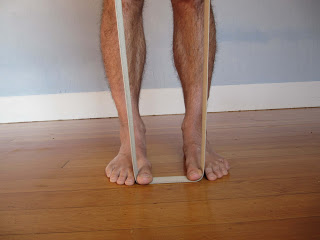
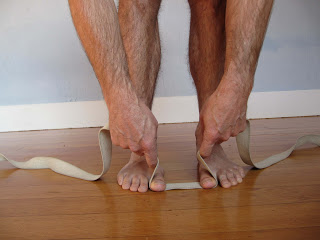
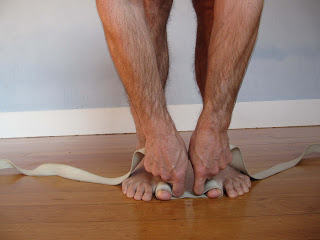
In addition to re-aligning these two parts of the foot and toe, the bones of the toe rolled a bit medially on their axis. Donald made an offhand remark about this being beneficial for treating bunions (hallux valgus for you Latin lovers) and then we moved on. But treating bunions! Sweeter words were never spoken. I come from a family of bunion formers, my mom’s mother, my wonderful Grandma Lopresto, had an impressive one on each foot for as long as I could remember. Interestingly, I don’t remember her complaining about them much.
What, you may be asking yourself, is a bunion? Well, a bunion is a condition in which your big toe deviates toward your second toe instead of lining up with your first metatarsal. And although bunions have a genetic component and do tend to run in families, another huge factor is shoes that smash the toes together. While these shoes are often for fashion purposes only, I do teach to one group of students whose shoe wear is all about function and their passion for climbing. And while the shoes these folks wear help keep them on razor thin ledges, they do lots of harm to their impressionable toes and feet.
According to the PubMed Health website, bunions occur more commonly in women and people born with abnormal bones in their feet. Certain kinds of shoes—specifically narrow-toed, high-heeled shoes—may also lead to bunion formation. And although it can seem a bit unsightly, it is only when pain develops that most people seek help.
How can you tell if a bunion is starting to form? Look at the place where your big toe meets the rest of your foot, along the inner edge of the foot. Do you see a bump forming there or is the tissue thicker than on the other foot? On the other side of the big toe—where it meets the second toe—do you see a callous? Both could be indications a bunion is developing. Also are you starting to have pain in that joint? That’s another potential sign! And certain shoes can aggravate that pain, especially narrow toed ones
What is the mainstream treatment for bunions? First off, they often tell you to wear different shoes, ones with a low heel and a wide area for the toes. That alone could do the trick. Sometimes special pads can be placed on the bunion or between the big and second toes, and wearing a toe spacer at night can start to influence the alignment of the toes. If that does not work, there are only a mere 100 different surgical approaches to treat bunions. One of my long time students has had both toes operated on, and says it made a huge difference for her, eliminating the pain. However, it has had an effect on her balance.
So, here was Donald offering up a really simple way to affect the toes! A few years back, my colleague and friend JJ Gormley shared her favorite method to get the big toe back on track, which you can do at your desk. With your feet parallel, place a can of your favorite organic goodies between your inner arches and put a veggie rubber band, one of those strong ones, around the big part of your big toes, so they deviate a bit towards the midline between your feet. You can do this for 10-15 minutes a few times a day, and watch for results.
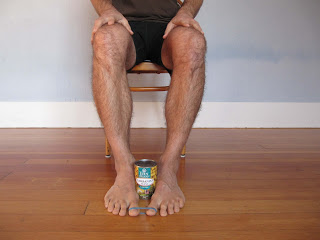
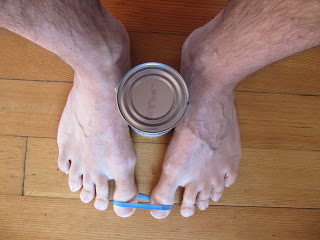
Obviously, if either Donald or JJ’s techniques result in worsening symptoms, stop them right away! But if not, give it a go. And remember, since a lot of the problem stems from being in shoes, yoga itself can go a long way to help the problem, as you are barefoot and you are strengthening and stretching many of the muscles and other structures that can affect the big toes.
For more information on yoga and bunions, there is a good article by Doug Keller in Yoga + Living Magazine from 2008 that you can find online. I hope the photos of Donald and JJ’s bunion recommendations are helpful in your home practice.
Follow Yoga for Healthy Aging on Facebook ° To order Yoga for Healthy Aging: A Guide to Lifelong Well-Being, go to Amazon, Shambhala, Indie Bound or your local bookstore.


And would you do the same if only one foot has a bunion?
Yes, go ahead and do the same, even if only one foot has a bunion. (That's often the case for most people.)
Randomly came across this, and I too have one bunion, and maybe the other foot is starting to show signs… annoying as i'm a 20yr old who doesn't wear/like heels. Generally it happen for older people i'm told… I'll give this a go and let you know how it goes! thanks for the tip! The photos are a great help.
This looks like a good practice, but bunions have nothing to do with footwear. It's genetics and the way we walk. It's a stupid myth that blames women for this common problem. Go ahead a wear heels if you want. It doesn't make a difference! However, any tight footwear will cause pressure on a sensitive area. Incidentally, men have them as often as women and wear heels much less often; they just don't go to the doctor as often, so it's seen as a women's problem.
my name is aimee I have used the toe straightener i have used at night this has caused my two toes bones to grind will walking causing more pain then i have ever got from the bunion p;ease help i'm 35 i'm in so much pain
Aimee, Baxter recommends that you visit a doctor or podiatrist in your area. Unfortunately, he can't help you without seeing you in person. —Nina
I'm getting a bunion on my right toe. Not from wearing cute sexy high heels because at least that would be fun. No I'm getting a bunion from trying to reach the gas pedal on my car!
My husband has bunions on his pinkie toes- I tried to find the article by Doug Keller, but I can't find it (the Yoga + Living website doesn't seem to have the pdfs for the first two issues that year). Can you please give us some recommendations?
http://www.doyoga.com/articles_all/15_nov_08_bunions.pdf
My 9-year old daughter has a bunion and she does not wear shoes – she even goes to school barefoot!
I wear heels once in blue moon, but that makes a hell of a difference. Last time I wore them I was left with 2 days long bunion ache. Also wearing shoes half or more smaller has the same effect. I am a tall bigfoot so this is from my own experience. And yeah once you started growing this fabulous thing it doesn't matter what shoes you wear because just walking makes it worse. That's how it is for me.
I wish my pops took me to my doc strait when I started moaning about my bad luck with shoes and that the right one was always weirdly fitting and bit misshaped. It wasn't the shoe but my foot! But that wasn't visible at the time. It took about 5 years to become visible… Well… good luck exercising! Take pics for compare!! x
Very eager to try these exercises to help correct my bunions. Will update you with results!
Here is a link to a PDF of an article about Bunions by Doug Keller.
http://www.doyoga.com/articles_all/15_nov_08_bunions.pdf
Dear all,
Do you have any suggestions on working with small bunion, bunion on the outer foot (small toe side) It is difficult to find any tips on working with this particular deformity of the toe! Big thank you in advance! Boyana
I include toe exercises in my yoga class … which included the keeping of toes down and bringing big toe inward, keeping toes down and lifting only big toe, keeping big toe down and lifting toes, and the ever popular keeping little and big toe down and raising and lowering middle toes (great for plantar fasciitis). My teacher always did them in her classes.